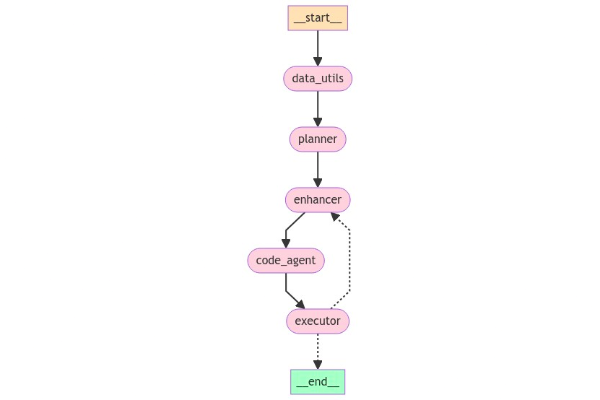Revolutionizing Kaggle Challenges: Introducing the AI-Powered Problem Solver
Revolutionizing Kaggle Challenges: Introducing the AI-Powered Problem Solver
In the ever-evolving world of data science and machine learning, Kaggle stands as a beacon for aspiring and seasoned practitioners alike. But what if we could supercharge our approach to these challenges? Enter the Kaggle Problem Solver - an innovative AI-powered system designed to tackle Kaggle’s machine learning problems with unprecedented efficiency and adaptability.
The Genesis of an Idea
As a data scientist and machine learning enthusiast, I’ve spent countless hours poring over Kaggle challenges, strategizing approaches, and refining models. It was during one particularly grueling competition that a thought struck me: What if we could automate not just the model training, but the entire problem-solving process?
This idea gave birth to the Kaggle Problem Solver - a system that combines planning, task enhancement, code generation, and execution into a cohesive, AI-driven workflow.
The Anatomy of the Kaggle Problem Solver
At its core, the Kaggle Problem Solver is composed of several key components:
- Data Utils: Handles initial data processing and preparation.
- The Planner: Crafts a step-by-step plan to tackle the challenge based on the problem description and dataset information.
- The Task Enhancer: Adds detailed specifications and requirements to each step in the plan.
- The Code Generation Agent: Generates the necessary code to execute each enhanced task.
- The Executor: Runs the generated code in a notebook environment, capturing outputs and results.
The Magic of Synergy
What makes the Kaggle Problem Solver truly powerful is how these components work together. Let’s visualize this workflow:
%%{init: {'flowchart': {'curve': 'linear'}}}%%
graph TD;
**start**[__start__]:::startclass;
**end**[__end__]:::endclass;
code_agent([code_agent]):::otherclass;
planner([planner]):::otherclass;
executor([executor]):::otherclass;
enhancer([enhancer]):::otherclass;
data_utils([data_utils]):::otherclass;
**start** --> data_utils;
code_agent --> executor;
data_utils --> planner;
enhancer --> code_agent;
planner --> enhancer;
executor -.-> **end**;
executor -.-> enhancer;
classDef startclass fill:#ffdfba;
classDef endclass fill:#baffc9;
classDef otherclass fill:#fad7de;
This cyclical process allows for continuous refinement and adaptation, mirroring the iterative nature of data science work but at a much faster pace. Let’s break down the flow:
- The process starts with data preparation using the Data Utils.
- The Planner then creates an initial strategy based on the prepared data.
- The Task Enhancer refines each planned task with specific requirements.
- The Code Generation Agent creates the necessary code for each enhanced task.
- The Executor runs the code and produces results.
- Based on the execution results, the process either concludes or loops back to the Task Enhancer for further refinement.
This adaptive cycle ensures that our approach remains responsive to new insights gained during the problem-solving process.
Key Features That Set It Apart
Adaptive Planning: The system doesn’t just stick to a predefined plan. It learns and adapts as it goes, much like a human data scientist would.
Context-Aware Code Generation: Each piece of code is generated with full awareness of what has been done before, ensuring a cohesive and progressive approach to the problem.
Robust Error Handling: The Code Generation Agent doesn’t give up at the first sign of an error. It implements multiple iterations and checks, continually refining its output.
Flexible Configuration: The system is designed to be highly configurable, allowing it to adapt to different types of Kaggle challenges and various computational environments.
Data-Driven Initialization: By starting with the Data Utils component, the system ensures that all subsequent steps are grounded in a solid understanding of the dataset.
The Road Ahead
While the Kaggle Problem Solver is already a powerful tool, I believe we’ve only scratched the surface of its potential. Future enhancements could include:
- Integration with AutoML tools for even more sophisticated model selection and hyperparameter tuning.
- A visual interface for real-time monitoring of the problem-solving process.
- Collaborative features allowing multiple AI agents to work together on more complex challenges.
- Enhanced data preprocessing capabilities in the Data Utils component.
- More advanced feedback loops between the Executor and other components for even better adaptability.
Conclusion
The Kaggle Problem Solver represents a significant step forward in how we approach machine learning challenges. By automating and optimizing the problem-solving process, it not only speeds up our work but also has the potential to uncover novel approaches that a human might overlook.
As we continue to refine and expand this system, I’m excited to see how it will transform the landscape of competitive machine learning. Who knows? The next Kaggle grandmaster might just be an AI.
Stay tuned for more updates, and happy problem-solving!
Have you tried using AI to automate your Kaggle workflow? Share your experiences in the comments below!
